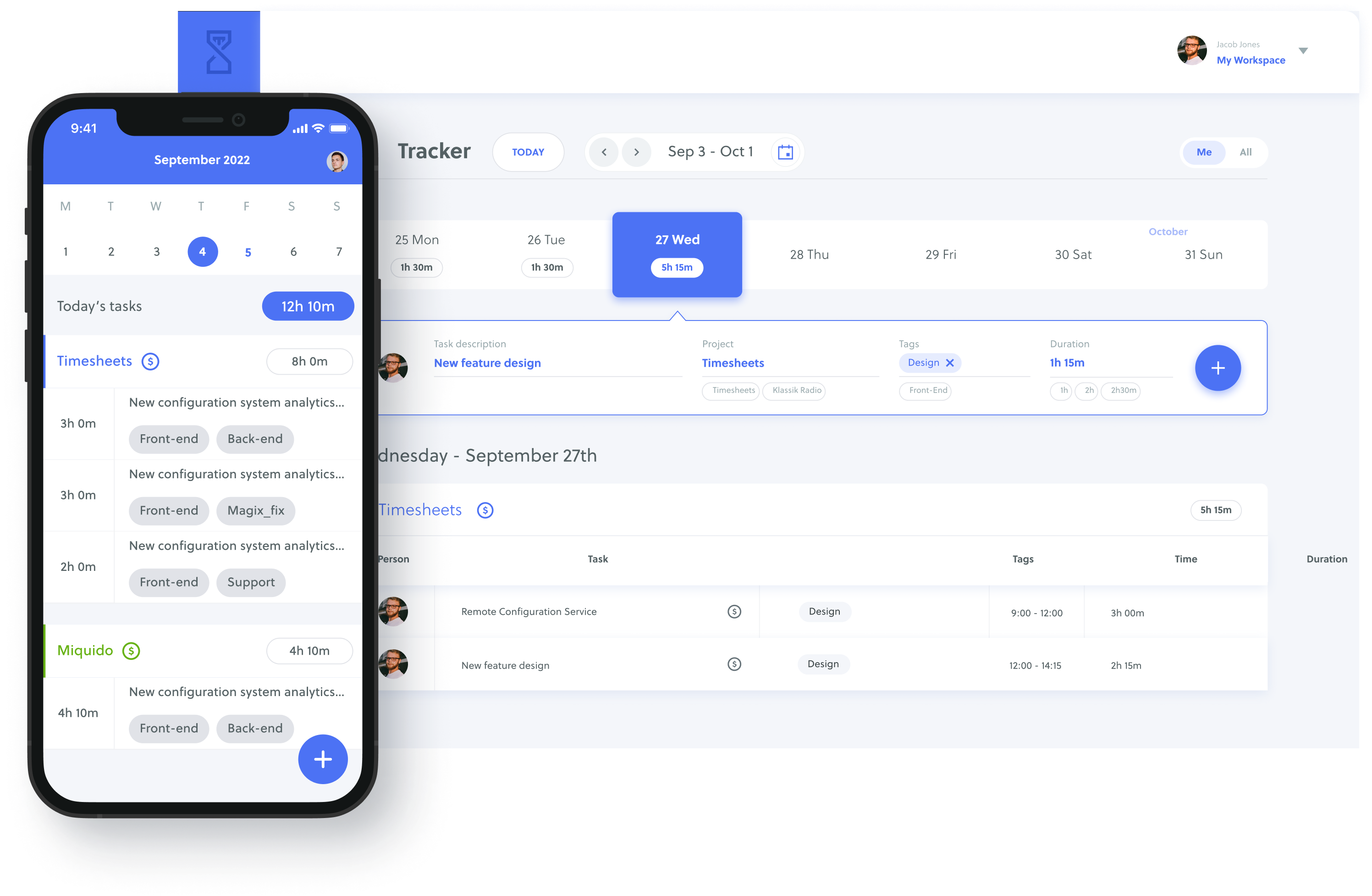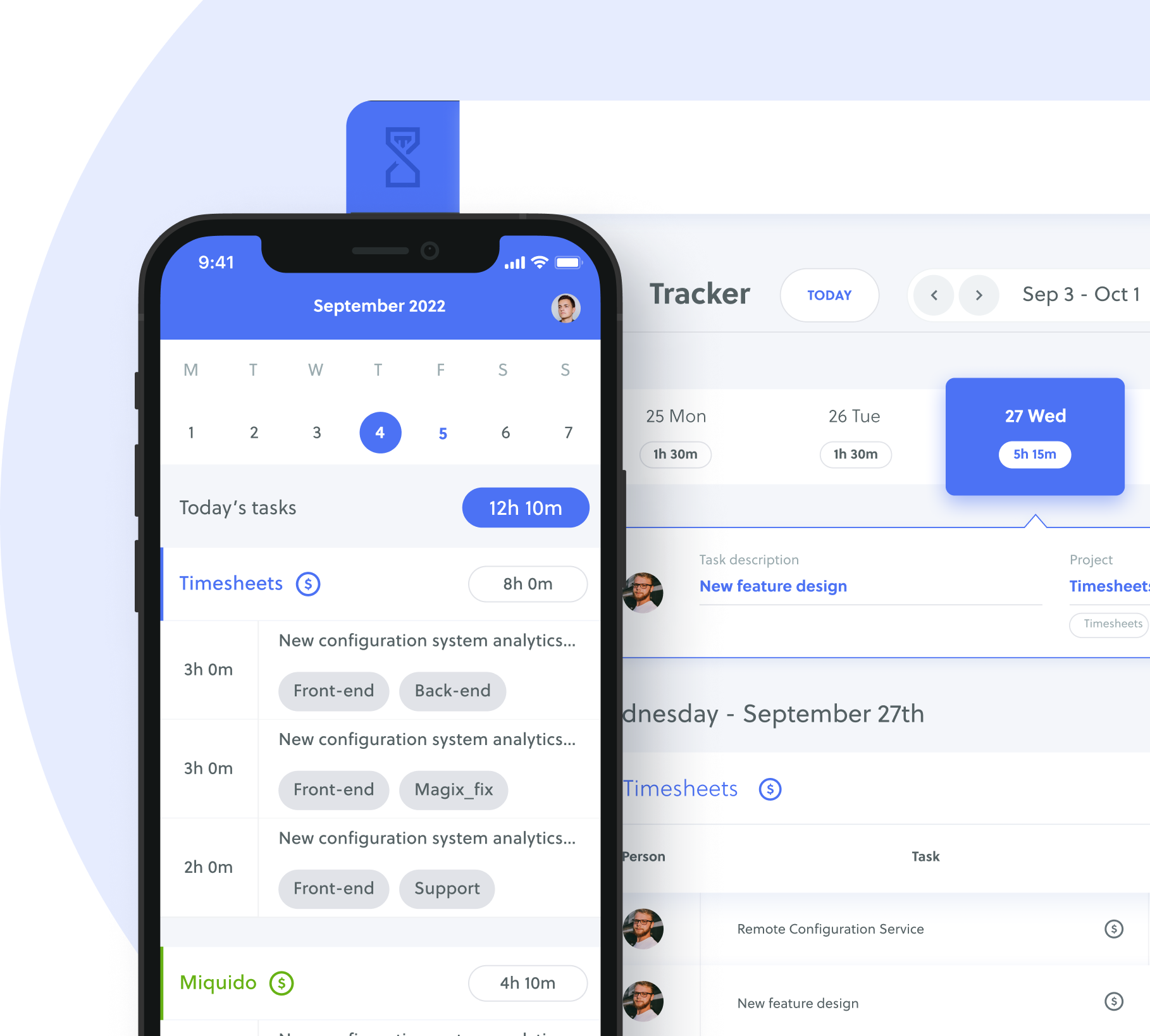While the hybrid work model has been around for a while, the skyrocketing of remote work during the COVID pandemic has boosted its popularity like never before.
And even though companies around the globe return to office work as the world opens back up, remote work is here to stay. For most businesses today, the future is neither completely office nor remote but instead a mixture of the two. This is where the hybrid work model comes in.
In this guide, we’ll take a closer look at hybrid work, its advantages and disadvantages, the best hybrid work practices, management tips, tools, and beyond.
We’ve also included some considerations to help you balance your time at the workplace and create your own hybrid work schedule.
Let’s begin!
Table of Contents
What Is a Hybrid Work Schedule?
A hybrid schedule is a type of work schedule that allows an organization’s employees to perform their tasks both on-site and at home, usually alternating between the two.
It is a flexible approach that combines the best of both worlds, giving employees the freedom to choose where and how they work best.
Hybrid schedules have been gaining popularity because they offer autonomy to employees to design their work week in a way that best suits both them and the company’s interests, leading to higher overall productivity.
Types of Hybrid Work Schedules
With time, companies have molded hybrid work schedules to best fit their workflow and interests, and many different types of schedules have come to the surface.
Companies today have great freedom to single out, select, and customize a hybrid schedule that works well with their organization’s needs. While the possibilities are limitless, here are some of the most popular hybrid work schedules:
Remote-First Hybrid Work Schedule
As the name implies, this schedule greatly favors remote work, but it doesn’t entirely eliminate on-site work either.
In a remote-first program, employees are typically allowed to choose their own work setting. For instance, they can create a schedule where they work on-site two days a week and remotely on the remaining days.
This type of schedule is an excellent option for teams that dislike the pressure of a prearranged plan and want to enjoy the flexibility of changing their work setting from time to time.
It also works well for businesses that operate inter-city or globally and those that want to keep the on-premise option at hand.
But one downside of this model is there could be a lack of in-person engagement if most employees choose to work mostly from home.
Office-First Hybrid Work Schedule
If you’d like your team to come into the office and collaborate in person but still want to give them the option of working from home every now and then, the office-first work schedule would be the right fit for your business.
In this type of schedule, employees may be given a fixed number of days per month where they can choose to work from home and a minimum office time they must be present for.
Cohort Hybrid Work Schedule
This is a type of hybrid work arrangement that allows employees to work both remotely and in the office. It typically involves dividing employees into cohorts or groups and assigning each group specific days to work in the office and specific days to work remotely.
This type of schedule can help organizations maintain social distancing while still allowing their employees to collaborate in person.
One common type of cohort hybrid work schedule is the 3:2 model, where all members of the cohort work on-premise three days a week and remotely two days a week at the same scheduled times.
With this type of model, it’s essential to have a carefully planned schedule so that your teams know exactly which days they’re expected to show up at the office and when they can work remotely.
Flexible Hybrid Work Schedule
This type of schedule places equal emphasis on both remote and in-person working. There is no specific prearranged plan for employees. Instead, they are given the flexibility of arranging their own schedule, working on-site every once in a while, and remotely whenever they wish.
This model works well for small-scale businesses with less than a hundred employees. However, there can be a risk of a lack of structure with this model, and proper communication channels must be put in place so hybrid employees can stay connected and work as a team, even when not on-site.
Hybrid Work Schedule – Benefits for Employees?
If your organization has offered you the opportunity to follow a hybrid work schedule, you must understand what you’re signing up for.
Here are two important advantages a hybrid work schedule can bring to employees.
Better Well-Being
According to data from Microsoft, one in five global survey respondents felt their employer did not care about their work-life balance.
This is something a hybrid work schedule can tackle. It allows workers to have a better work-life balance, which in turn promotes their well-being.
That’s because hybrid working enables employees to fit their work and life together in a way that suits them, have more opportunities to indulge in self-care, spend more time with friends and family, and focus on their mental and physical health.
More Autonomy Over Schedule
A highly rigid corporate environment can often make workers feel like they are simply a cog in the machine, working solely for company profit.
On the other hand, a hybrid work schedule gives workers autonomy over what they do, which is vital for their satisfaction. If workers have total flexibility to decide when, how, and where they work, they’ll be able to perform better and feel more valued and appreciated at work.
Hybrid Work Schedule – Benefits for Companies?
When planned carefully, the hybrid work model has the potential to improve your organization in several ways. Here are three major advantages of a hybrid work schedule for companies.
Increased Productivity
A hybrid model allows employees flexibility and freedom to choose how they work, which helps them make the most out of a business day.
For instance, if an employee works better in the evenings after taking a long lunch break or can focus more in a quiet room as opposed to a noisy office, a hybrid work model will allow them to play to their strengths and work how they work best. This is called flextime.
Greater Focus On Learning
Most organizations are performance-driven. While this is not necessarily bad, solely focusing on employee output is not the best business practice.
If you’re only measuring growth in terms of employee productivity, you’re missing out on a critical element — how much your employees are actually learning at work.
Remember, an output-focused workplace often neglects employees’ long-term development and masks an exhausted, burnt-out workforce.
And as a business leader, it’s essential to understand that if your employees are too exhausted by back-to-back meetings, they will have no time or energy for reflection, growth, and creativity.
A hybrid work model, however, can help put the focus back on learning by allowing employees to take time for self-development, learning, and reflection.
Access to a Global Talent Pool
When you switch to a hybrid work model, you can suddenly access a much larger talent pool globally. This opens up the doors to more diverse and skilled workers who may not be able to work in a traditional office setting.
That, in turn, can create an exciting and dynamic working environment that encourages collaboration, exchange of ideas, and innovation.
General Disadvantages of Hybrid Work Schedule
While a hybrid model can be very promising, it has two major downsides. These include:
Cybersecurity Risks
With teams handling important company data outside of the office, there is automatically a higher risk of a security breach. However, there are some simple ways you can tighten cybersecurity when implementing a hybrid model.
These include:
Using reliable hybrid working software
Educating your employees on how to safely handle and access information outside of company premises
Ensuring every single employee has a secure internet connection
Encouraging the use of firewalls and VPNs
Limiting access to confidential information
Risk of Workplace Inequality
With a hybrid work model, there is a greater risk of something called a “proximity bias.” This is the unconscious bias that gets created in the workplace where employers end up offering advancement opportunities to workers who work on-site simply because they see them more frequently.
To avoid this, it’s crucial to find a way to bridge the gap between on-site and remote employees and ensure each employee has an equal chance to advance further.
For instance, you can provide open communication channels to remote workers, use the right tools to stay in touch with all employees, give each employee equal access to information, and use objective performance indicators to judge employee performance.
How to Create a Hybrid Work Schedule
Once you’ve determined which hybrid work model is right for your company, follow this step-by-step guide to create your own hybrid work schedule.
Communicate With Your Employees
Since your employees will be the most affected by this change, you must speak with them about it first.
So conduct surveys/meetings to collect employee feedback about a hybrid working model.
Try to consider each employee’s preferences wherever you can — determine who works best on-site and who will thrive remotely, and build a hybrid model that accommodates both kinds of employees to ensure maximum satisfaction and productivity.
Create a Schedule
After some input from your employees, it’s time to get to work. When creating your calendar, consider the following questions:
Do you need somebody from each department on-site every day?
Do some teams collaborate better than others?
Does an alternative day schedule work for your employees?
How often do you need supervisors on site?
Should there be days when the whole team is on-site?
How many days will employees work remotely?
How will you maintain employee engagement?
How will you calculate the hours worked by remote employees?
You should also remember that different tasks have different requirements. Consider inviting employees to the office only for collaborative events, such as networking, brainstorming, and important meetings.
Consider Your Office Set Up
If you’re sticking with your old business premises, you might need to adjust your office space to better suit hybrid work. For example, if a majority of your employees will work remotely, you may consider downsizing to save money on office rent and maintenance.
Also, make sure to have a collaboration-focused, simple interior design where on-site workers can focus and perform their best. For meeting room layouts of your hybrid workplace, set up the space to accommodate both physically present employees and those that will join in virtually.
Invest in Equipment & Software
Investing in the right equipment and software is integral to the success of your hybrid work policy.
Consider implementing collaboration technologies such as an interactive display in the main work area and invest in a good project management tool for an efficient hybrid work environment.
We’ll talk more about tools below.
Update as You Go
Just because you’ve implemented a hybrid work schedule doesn’t mean it is set in stone. Keep a trial period of about two weeks or more, and then revisit your schedule and see how your employees have performed.
Take their complaints, critique, and suggestions on board, and constantly review to see how the workflow can be improved. Mishaps are normal in the beginning, but with constant upgrading and tweaking, you can easily implement a successful hybrid work program.
Hybrid Work Schedule Best Practices
Like any major organizational change, a hybrid work schedule requires complete commitment, hard work, and constant effort to succeed.
If you’re not careful, adopting a hybrid model may lead to a decline in employee satisfaction, productivity, and retention. To avoid this, here are some of the best practices you should implement.
Prioritize Communication
Regular and clear communication is the most important practice for a successful hybrid work policy. It is important that you stay in touch with all your teams and that teams have open channels of communication with each other.
So, invest in team collaboration tools and project management software to ensure remote employees do not feel left behind. Also, hold regular meetings, make them accessible both in-person and virtually, and don’t hesitate to call everyone on-site when necessary.
The more you communicate with the people who make your organization, the more engaged, satisfied, and productive they will be.
Embrace Flexibility
Not all schedules are suited to all businesses. If you’ve initially implemented a remote-first policy but then realize you need more people on-site, don’t be afraid to change up your schedule.
A hybrid work schedule is all about flexibility, and you should prioritize flexibility even in its implementation.
Set Clear KPIs
When employees are not physically present, it can be a bit difficult to keep track of their progress. For a holistic view of the impact of hybrid working on your employees’ work, make sure to set very clear Key Performance Indicators.
For instance, set requirements for the number of articles written, sales calls made, meetings attended, or tasks completed. This can help you stay on top of each employee’s performance and help them improve if needed.
Tips on How to Manage Your Individual Hybrid Work Schedule
Going from on-site work to a hybrid model can be disorienting at the start. Here are three important tips on how to better manage your individual hybrid work schedule.
- Set a clear division of tasks. Identify which tasks you prefer to do in the office (such as attending meetings, reviewing tangible items, or working with highly emotional content) and which you’d rather do from the comfort of your home.
- Understand how best to maximize your productivity. Determine which days and timings you’re more motivated to go in at work and customize your schedule to how you personally work best.
- Identify when you feel the least motivated (for instance, a morning meeting on Fridays), and try to figure out ways to adapt your schedule to overcome this problem (such as going to the gym for an energy boost or sleeping earlier the night before).
Right Tools for Hybrid Workers
A hybrid work model has an additional layer of complexity that requires some extra tools to help ensure a smooth workflow.
Examples include:
Task management tools like Asana
Tools for working across different time zones, such as TimeTemperature
Virtual meeting apps like Zoom
AI tools to improve communication with your remote team, such as Krisp
Scheduling tools like Calendly for online meetings
Writing tools like Grammarly to optimize written communication
Cloud storage solutions like Google Drive for document sharing and collaboration
The exact tools you decide to use will depend on your individual needs and how you want to manage your remote team. However, the key is to look for tools that make it easier to collaborate remotely with your team and to keep everyone in sync.
Final Words
We hope this post has helped you better understand the concept of hybrid working and what it takes to implement a successful hybrid work policy.
As with any new system, there will always be challenges, but with the right tools and strategies in place, you can create a successful hybrid work model that works for everyone. Good luck!







